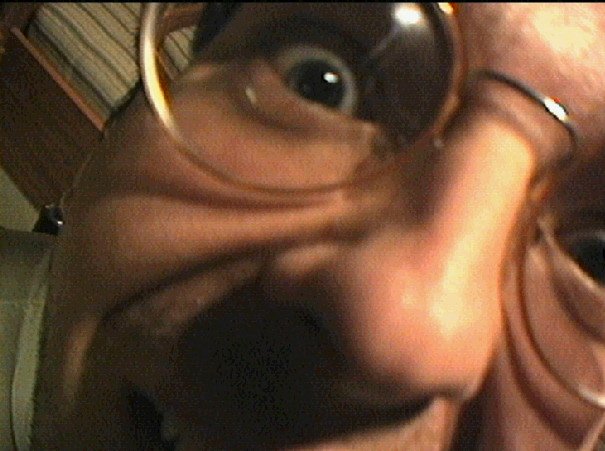 Back to GanjaTron's Site
Back to GanjaTron's Site
Epson HX-20
"Actual Size"
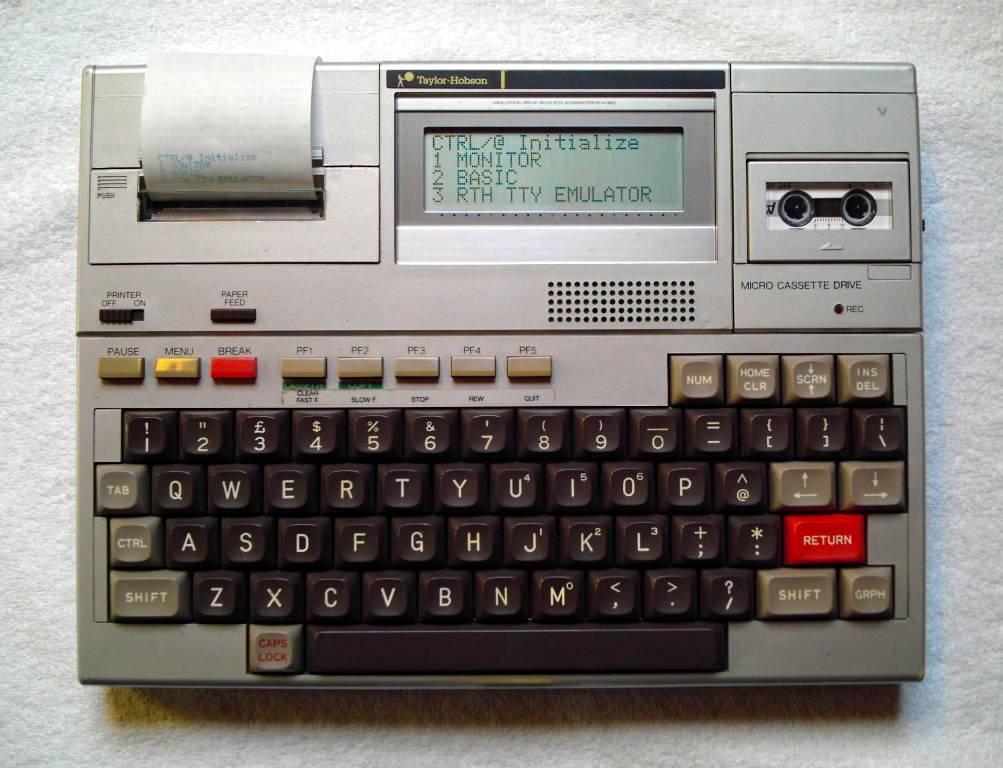
Epson HX-20 in Taylor-Hobson guise. [Click to enlarge]
History
The HX-20 revolutionised computing in the early 80's. Arguably the first notebook, it was definitely the first truly portable system at a reasonable price. It was preceded by a series of sewing-machine-cased, mains-powered luggables such as the Osborne 1 and Kaypro, weighing as much as 12kg and barely fitting under an airplane seat (quoting the ads). More compact developments followed, some of which came close to the notion of a modern laptop (notably the GRiD Compass), but were out of the reach of consumers due to high cost and primarily used in government installations.
Epson stunned the world when it unveiled this baby in 1982. Though not without its faults and limited in some ways, the HX-20 was nothing short of a revelation, and paved the way for computing on the go for the masses. It was the first in a series of pioneering laptops Epson would release in the course of the 80's.
In his review of the HX-20 in march 1983, David Ahl of Creative Computing had this to say:
"The HX-20 is a quantum leap forward in putting the power and capability of a full computer in a compact package. ... For working on a plane, train, or away from the office the HX-20 is unrivalled. How often have I dreamed of having a spreadsheet or word processing computer with me on cross country or transatlantic plane trips! It would seem that the HX-20 is the answer to these dreams."
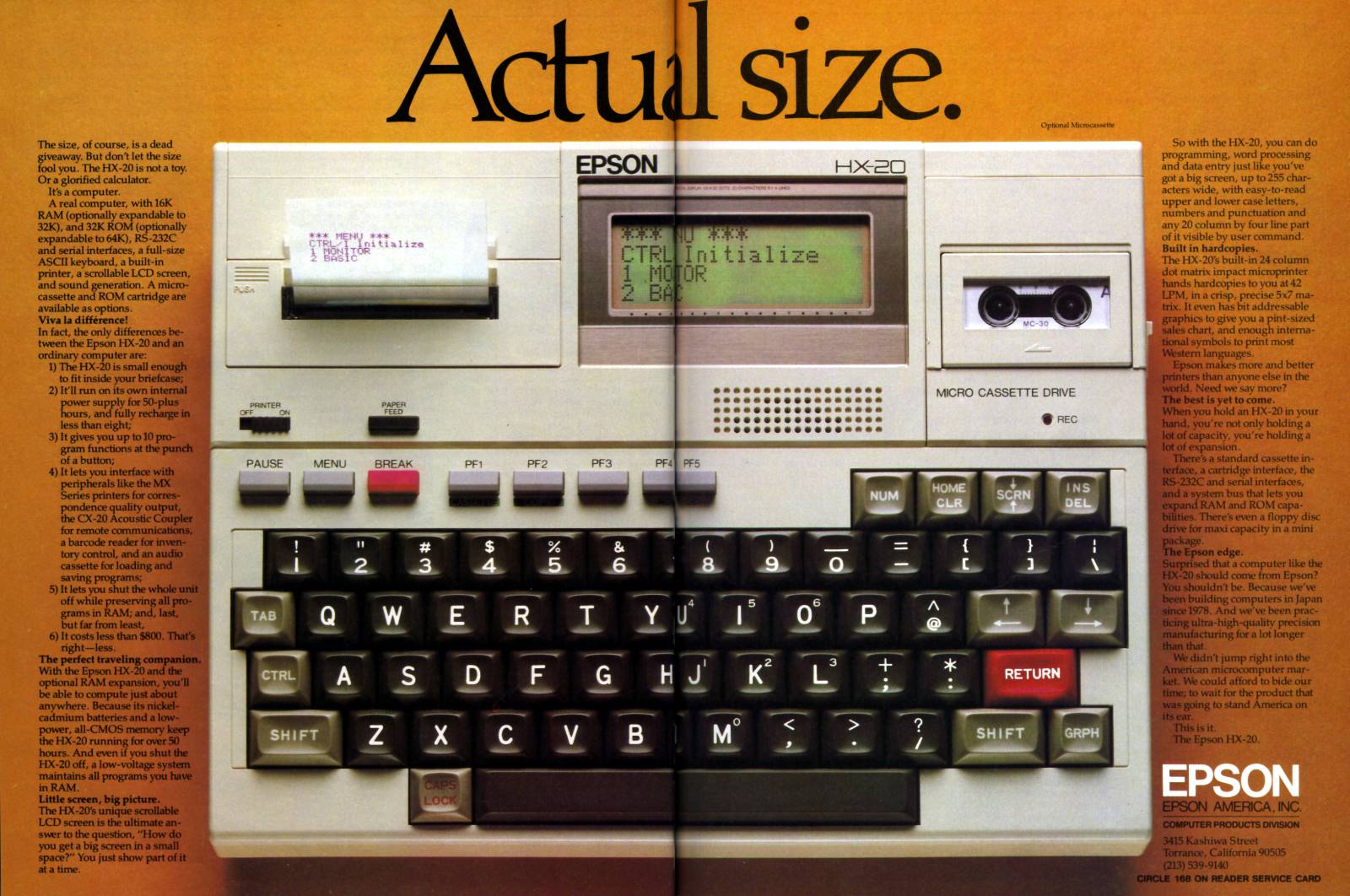
| Epson announced the HX-20 to the world in this famous double page ad spread from 1982. Its compact size is obviously the big selling point here. [click to enlarge]. |
The HX-20 was obviously targeted at the travelling business clientele, but also became extremely popular with journalists. The HX-20 added a new dimension to business travel; sales reps and columnists could Phone Home[tm] to their office from Ouagadougou and transmit files at a blazing 300 bps via the optional acoustic coupler. The optional barcode reader made the HX-20 ideal for inventory control as well. Other applications included data acquisition in labs. The HX-20 could basically be used in any transitory environment, certainly a novel concept back in '82.
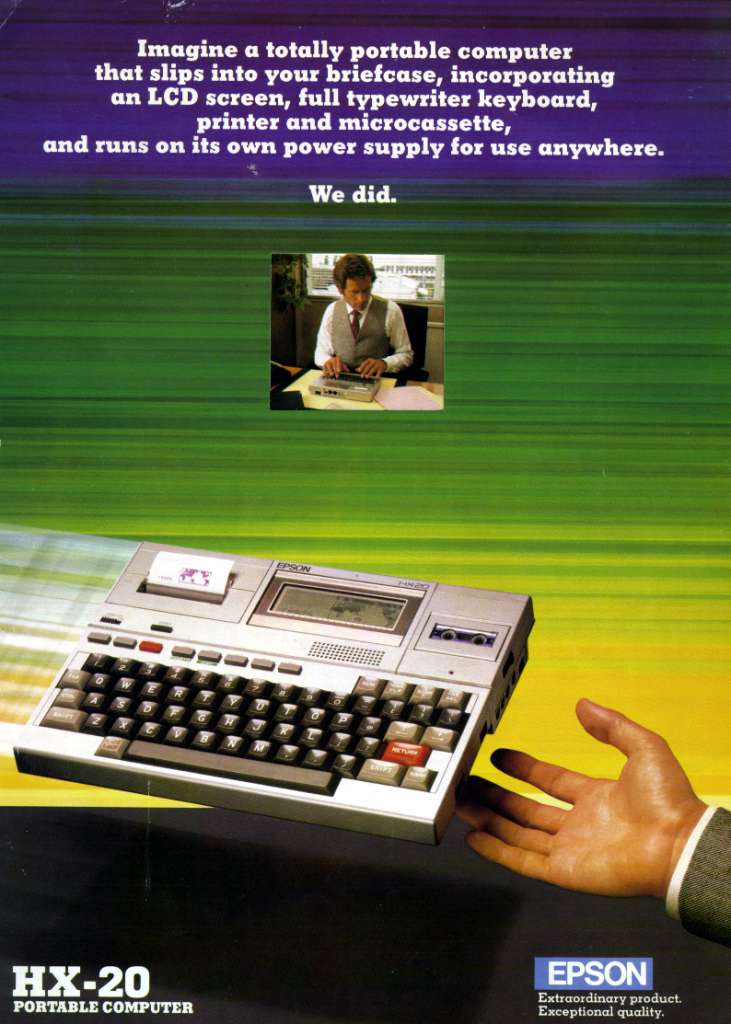
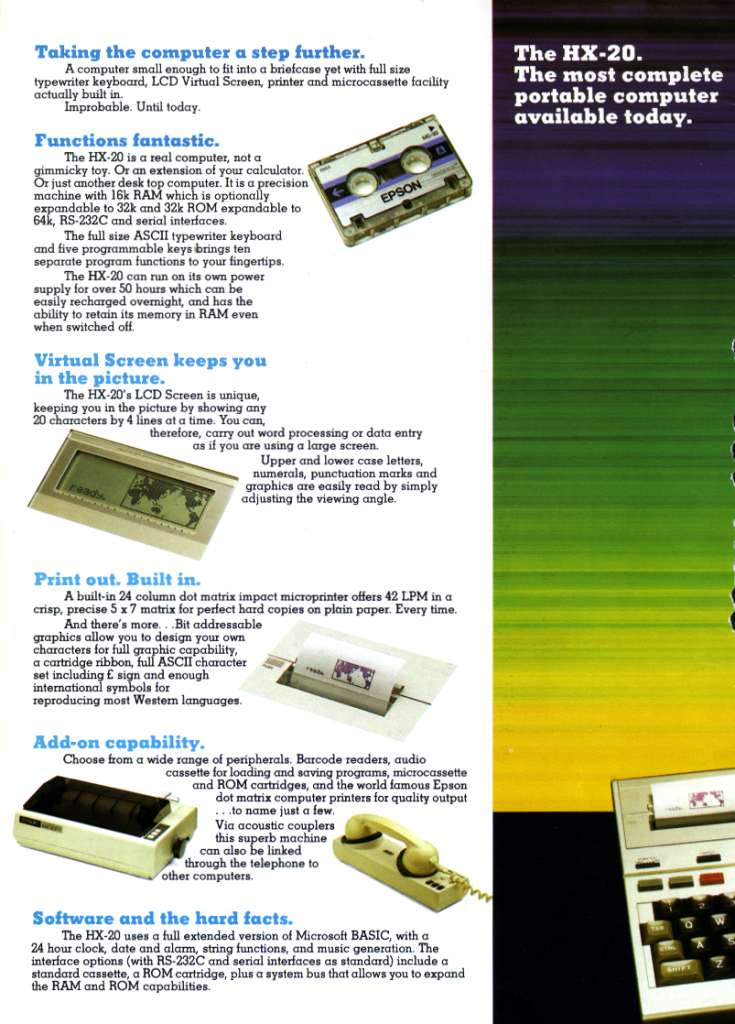


| Welcome to Yuppiedom: another elaborate four page (!) ad from Epson UK. Epson apparently wanted to make it clear only they had the farsight to devise such a compact computing platform. As depicted in the ad, the HX-20 is equally at home in the office, on the plane, in a power station (ok, maybe that's a stretch), and, well, at home. [Click to enlarge]. |
Incredibly, 25 years after releasing the HX-20 Epson still maintains a support page for it! How's that for support? :^)
Characteristics
The HX-20 comes with everything you need in a full fledged computer already integrated into the case: a keyboard, display, printer, and an optional microdatasette for mass storage -- this is not a glorified pocket computer. The size of an A4 page and weighing just 1.7kg, it's actually more compact than your typical modern 15"+ notebook!
The HX-20 comes with a 20×4 character LCD with adjustable contrast thumbwheel (labelled "view angle"). The small screen is infact a floating viewport into a large virtual screen as determined by the application (and available memory!) which can be shifted around with the SCRN key. Upon powerup, it displays a menu of possible applications to run at a mere keystroke, with BASIC and the system monitor always being the first choices. Other applications may be added to the menu by installing application ROMs and cartridges. User programs kept in memory (up to 5, memory permitting) may also be selected at startup. Quite a user friendly concept for its time.
The HX-20 is superbly engineered, if in somewhat odd detail. The motherboard is populated with CMOS components for low power consumption, including eight 2K static RAM chips instead of the then more usual (and cheaper) dynamic RAMs. There's also a clock and calendar built in to benefit from the battery backup, albeit not Y2K compliant. A unique feature are the twin CPUs consisting of two Hitachi 6301s working in tandem in a master/slave configuration. The master is the main CPU and handles the keyboard and display, while the slave drives the speaker, the built-in miniprinter, and an external datasette. The serial interfaces and cartridge/microdatasette are shared between the two CPUs, which communicate, interestingly enough, via a 38400 bps serial bus. How's that for weird? The 6301 is somewhat obscure and by all accounts compatible to the Motorola 6800. At 614 kHz these babies yield mediocre performance (comparable to the ZX81 in fast mode), but that's the price you pay for low power consumption and a very copious battery life.
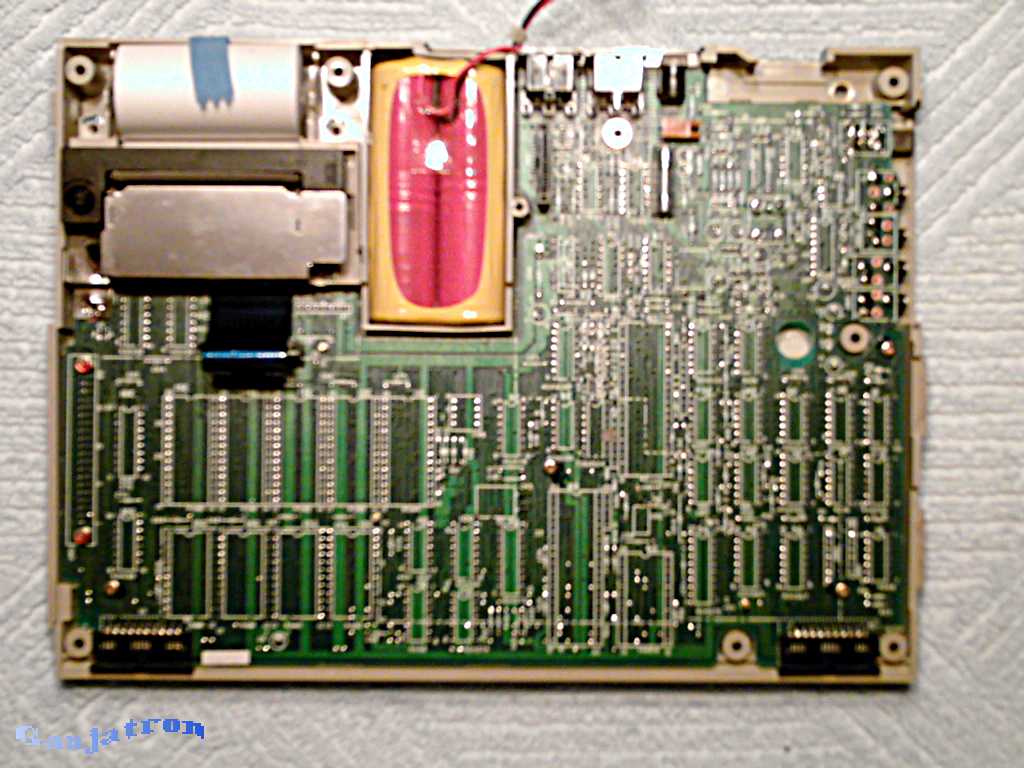
| Inside the HX-20. The motherboard is mounted component side down. Note the four sub-C NiCd cells. These are (were) still the original 1100mAh cells and completely dead. They've since been replaced [click to enlarge]. |
The power supply consists of four 1100mAh NiCd batteries. The HX-20's power consumption is phenomenally low even by today's standards, averaging around 0.1W and peaking at ca. 1.5W when using the printer or datasette. This gives the HX-20 an average battery life of about 50 hours -- that's about the tenfold battery life of an average notebook these days! Makes you wonder if something got left behind on the path to the modern laptop. The batteries are also responsible for backing up the clock and memory when the unit is powered down, thus preserving user programs. The HX-20 will infact also restore the machine state when powering up, so you can resume where you left off -- effectively the equivalent of the suspend to memory feature which has become standard on every notebook. Unlike modern notebooks, however, the HX-20 can remain in this state for weeks without running flat!
Though sophisticated for its time, the HX-20 also has two glaring shortcomings with regard to its batteries. It will not shut off after some period of inactivity to preserve battery life, a standard feature in even the most basic calculator. Furthermore, the battery charge is not monitored; the charging circuit is dumb and continually churns 125mA into the cells. It's up the user to monitor the charge duration (recommended eight hours with the original 1100mAh cells). If left plugged in too long, the HX-20 will cook its batteries! Like all NiCd's they are subject to ageing and eventually have to be replaced. My HX-20 still had its original cells; needless to say, these were dead and leaky after 20+ years.
Apart connectors for an external datasette, the HX-20 also offers built-in mass storage with the optional H20MC microdatasette cartridge, which accepts standard microcassettes used in dictaphones. The beauty of this gadget is that it's completely operated via software. Saving and loading is accomplished automatically -- no need to push play or record. The HX-20 maintains a 16-bit digital tape counter which is accessible from BASIC. A really nifty feature is the WIND command to automatically seek a specified tape counter position (usually only found on VCRs). A manual tape mode can also be selected to wind the tape via the function keys while displaying the counter. The microdatasette is also reliable (it actually saves each data block twice just to make sure!) and reasonably fast at 1300 bps. Simply put, this datasette puts the fun back into datasettes -- it's more entertaining than floppies!
The built in 24-column miniprinter chugs away at roughly 17 cps and yields a crisp printout of decent quality. Its substantial power drain must have motivated EPSON to provide a separate power switch. The printer is infact identical to those used in cash registers. As these accept the same ribbons, replacements are still available today!
The HX-20's resident BASIC is a remarkably comprehensive derivative of Microsoft BASIC with a number of extensions specific to the HX-20, including commands to access the microdatasette, miniprinter, ROM cartridge, clock/calendar, RAM files (!), an external display adaptor (see below), and other goodies. One of its less well rounded features are the cryptic, abbreviated error messages. It's pretty annoying having to look up a "BO error" or an "IE error" in the manual. I suspect limited screen space, rather than ROM space, drove EPSON to this decision. The character set is standard ASCII including lower case and reserved codes for up to 32 user-defined characters.
The HX-20's motherboard carries four 8K system ROMs containing the system monitor, operating system routines, and BASIC. These are accessible via a flap on the bottom of the case. Next to the system ROMs is an additional socket which can accept an optional 8K application ROM. A further 32K can be added with the H20RC ROM cartridge which latches into the datasette recess. Popular applications like terminal emulators and word processors such as SkiWriter are then immediately available without having to load them from tape. This concept of ROM-resident application software was to be elaborated on in later portables to include appointment calendars, address/phonebooks, and spreadsheets, among other things.
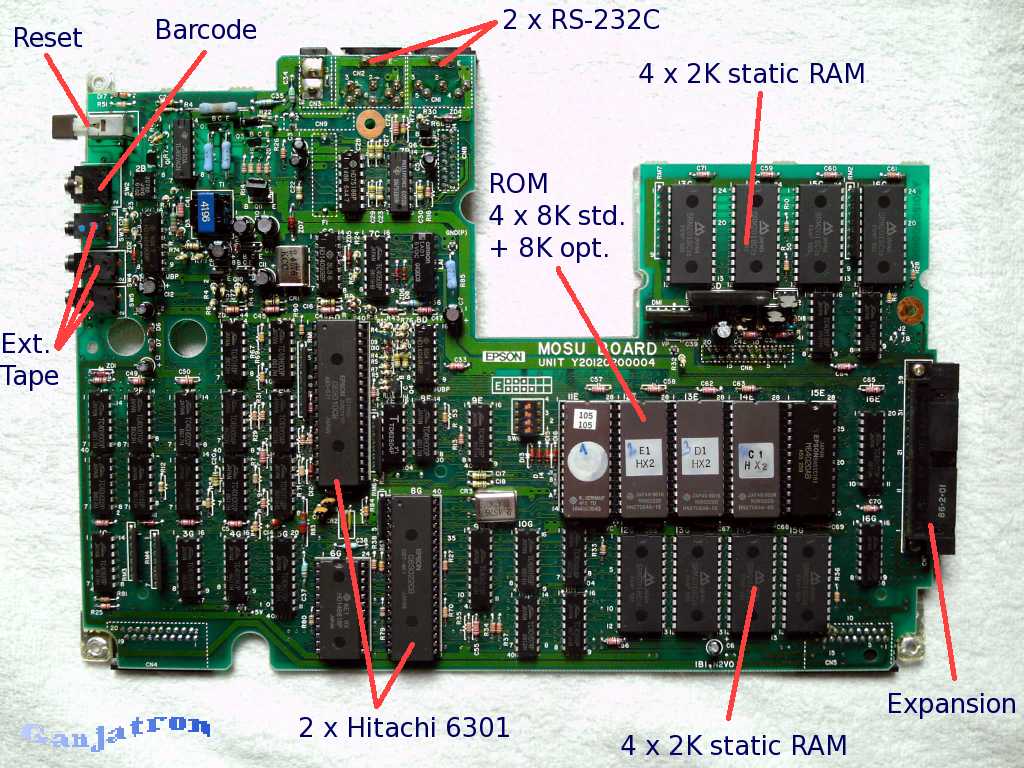
The HX-20 motherboard, labelled MOSU (?) [Click to enlarge]
The HX-20 could be expanded into a (then) powerful system, though of course compromising its portability. The most popular add-on is the H20EU expansion unit containing an additional 16K of RAM and sockets for up to 32K of yet more ROM. Among the more exotic and hard to find add-ons is the TF-20 floppy drive which connects to the high speed RS-232C port, providing 320 kb storage on 5.25" disks. This drive is intelligent as it contains its own Z80 processor and disk operating system in ROM -- very cool, babee! The rarest add-on is the H00DC-IA external display adaptor which also plugs into the high speed RS-232C port and redirects the HX-20's output to a monitor or TV and provides colour graphics capability!
My HX-20 is actually relabelled as a Taylor-Hobson, makers of precision instruments (basically there's just a sticker covering the original Epson logo). These units were presumably delivered as part of a lab installation and interfaced to their equipment. It contains an application EPROM with an RTH [Rank-Taylor-Hobson] Terminal Emulator. I have no idea how to work the thing, and there's no documentation or built-in help. It also appears Taylor-Hobson added some extra scientific symbols to the character set in the system ROMs. Apart from that the unit appears to be your standard HX-20, although other modifications may have been made as three of the system ROMs are also EPROMs instead of the standard mask programmed ROMs.
The HX-20 is without doubt one of the most remarkable retrocomputing collectibles around. Yet it is not even that rare: HX-20s sell regularly on eBay at reasonable prices. Its impact on the future of mobile computing as perceived in 1982 is indisputable, something we easily tend to forget in the light of the infinitely more powerful notebooks we now take for granted. And yet as crude as it may seem in comparison, the HX-20 is still around, still used and loved, and above all: it puts the battery life of any modern laptop to shame! Epson achieved something groundbreaking with this little gadget, and the fact they still offer support for it bears witness to its long-term appeal.
Hardware Issues
- Replacement of built in NiCd battery pack (4× Sub-C); either BYO (build your own) or ready made off eBay ($$$).
- Printer ribbon dries up; replacement type Epson ERC-09 still available as of 07/2011.
Specs
| Year of introduction | 1982 |
|---|---|
| Retail price | $800 |
| CPU | 2 × Hitachi 6301 (master/slave) at 0.614 MHz |
| RAM | 16K (up to 32K with H20EU expansion unit) |
| ROM | 32K with Epson-Microsoft BASIC and system monitor, Internal socket for additional 8K, Up to 32K in optional H20RC cartridge |
| Display | 120×32 monochrome LCD 20×4 text mode 128×64 (4 colours), 128×96 (monochrome) graphics with optional H00DC-IA external display adaptor |
| Audio | Piezo beeper |
| I/O | Cassette in/out/remote, Barcode reader (!), RS-232C serial via 8-pin DIN socket (up to 4800 bps), RS-232C serial via 5-pin DIN socket (up to 38400 bps), Built-in 24 column dot matrix miniprinter (17 cps), Slot for optional ROM or microdatasette cartridge |
| Storage | Optional built-in microcassette or
external tape drive (1300 bps), Optional TF-20 disk drive (320 kb) |
| Keyboard | Full stroke upper/lower case with autorepeat |
| Operating system | Proprietary, disk operating system residing in ROM on TF-20 disk drive |
| Power Source | 4× Sub-C NiCd 1.2V 6V AC adaptor/charger |
| Rarity | Common |
| Verdict | The granddaddy of all notebooks! |
Links
An HX-20 Enthusiast's SiteEpson HX-20 Programs (includes info for serial transfer)
Yet another computer museum (info on TF-20 floppy and lotsa PDFed docs!)
Back to Retrocomputing
 Back to GanjaTron's Site
Back to GanjaTron's Site